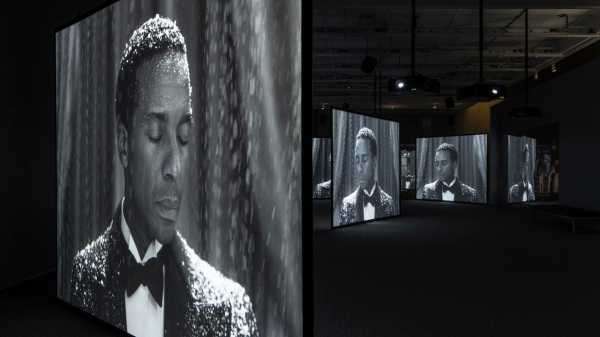
Alain Locke is remembered as a leader of the Harlem Renaissance largely for assembling “The New Negro,” a 1925 anthology that immortalized a small group of young writers—Langston Hughes, Claude McKay, Zora Neale Hurston, Jessie Fauset, and others—as America’s first Black literary movement. But, if things had gone differently, he might have left an even deeper mark in the visual arts. Among his greatest unrealized ambitions was to establish a Harlem Museum of African Art, where the next generation of sculptors, painters, photographers, and printmakers could draw inspiration from the continent as they enacted their own transformation of Black American identity. “We must believe that there still slumbers in the blood something which once stirred will react with peculiar emotional intensity toward it,” he wrote in a special issue of Opportunity devoted to African sculpture. “Nothing is more galvanizing than the sense of a cultural past.”
Grasping this legacy was anything but simple, as Countee Cullen suggested in his poem “Heritage.” Republished in Locke’s anthology alongside photographs of Dogon and Guro statuary, it asked whether a Black American “three centuries removed / From the scenes his fathers loved” could even relate to them beyond an empty longing for jumbled exotica: “Spicy grove and banyan tree, / What is Africa to me?” The art works, too, were victims of alienation. Ripped from African societies by colonizing armies, they’d become cheap curios in European markets—and then, reduced to bare form, aesthetic kindling for a burgeoning modernist movement. The sculptures that accompanied Cullen’s poem were from the Barnes Foundation in Merion, Pennsylvania, where “primitive” statuary was exhibited alongside works by Picasso, Modigliani, and other avant-garde devotees of l’art nègre. Salvaging a New Negro from this distorted chain of transmission would require much more than race pride and nostalgia. To claim African sculpture as their heritage, Black artists of the era had to devise new ways to look.
Locke’s fraught encounter with what he called the “ancestral arts” is the subject of “Once Again . . . (Statues Never Die),” Isaac Julien’s new video installation at the Barnes Foundation in Philadelphia. (It controversially relocated from Merion a decade ago.) Set around 1924, on the eve of the Harlem Renaissance, it’s a mesmerizing portrait of the philosopher, critic, and queer cultural visionary as a roving eye, determined to liberate the Black imagination through the alchemy of art. A five-channel black-and-white film follows Locke (played by André Holland, of “Moonlight”) through a series of vignettes that dramatize the complex entanglement of aesthetics and racecraft. At Oxford, where Locke faced prejudice as the first Black Rhodes Scholar, imposing marble statues of Aristotle and Leibniz loom like demigods; nearby, their African counterparts serve as primitive specimens in the university’s anthropology museum. It’s a stark demonstration of art’s power to naturalize racial domination—or, in a later scene, upend its terms. When Locke visits the sculptor Richmond Barthé (Devon Terrell), his protégé and occasional lover, the two gaze admiringly at a young model’s virile contours: the New Negro as a Black male Galatea, poised to step out of the workshop and transform American life. A haunting performance by the singer Alice Smith, which recurs throughout the film, underlines the pain and promise of cultural rebirth: “Once again, I begin . . .”
Locke proves an ideal subject for Julien, a recently knighted British artist and filmmaker whom the scholar Rinaldo Walcott has described as “the crown prince of Black queer cinema.” He’s known for his prismatic depictions of historical figures, often in elaborate multiscreen installations that mix archival video and dramatic reënactment. Many of his subjects are Black men—including Matthew Henson, Derek Walcott, and Frantz Fanon—and the aesthetics of Black masculinity are a preoccupation. “Lessons of the Hour” (2019), a ten-screen installation, explored Frederick Douglass’s transformative use of photography in the abolition struggle, a theme continuous with the new project’s consideration of race and modernist sculpture. Even closer is Julien’s breakout film, “Looking for Langston” (1989), an homage to the gay writers and artists of the Harlem Renaissance that drew parallels with the Black Gay Renaissance of the nineteen-eighties. “Statues Never Die” borrows a few scenes, songs, and an underground speakeasy from the earlier film, echoing its vision of a Blackness untrammelled by chronology. In his final scene, Locke, dusted in mysteriously ascending snowflakes, closes his eyes and quotes the late bell hooks, invoking a “mythical diasporic dream space” where “a culture of infinite possibility is ready to receive us.”
Julien’s installation is a dream space all its own. Playing on five double-sided screens in a darkened gallery with mirrored walls, the thirty-minute film is visible no matter where you look. Reflections interpolate visitors into the play of gazes; watching others, and being watched, in encounters with art, one becomes intimately aware of how aesthetic categories creep into the assessment of other human beings. Finally, a group of sculptures exhibited on either side of the room evokes Locke’s unrealized museum: African masks and statues from the Barnes collection; Richmond Barthé’s neoclassically inflected Black figures in bronze; and five striking works by the contemporary artist Matthew Angelo Harrison, who entombs cheap African statues made for the tourist trade in transparent blocks of polyurethane. He then carves patterns into the resin with computerized machining tools—a visceral evocation of colonial violence and the alienation that Cullen described in “Heritage.” It looks as if someone has tried, and failed, to prise out the statue within.
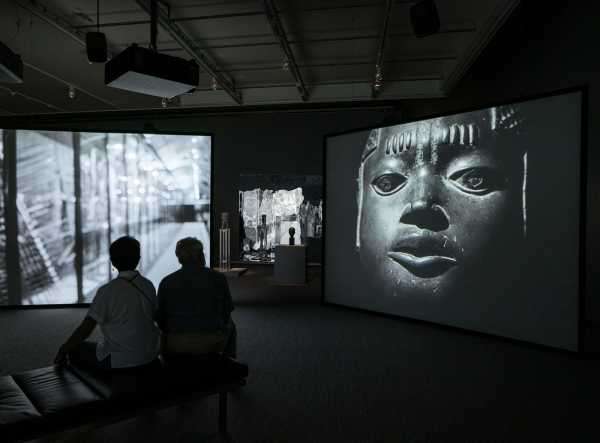
The project’s animating tension derives from the collision of Locke’s dream with the realities of power. African sculpture was scarcely accessible to Black Americans of the early twentieth century, except through white collectors who often had agendas of their own. Accordingly, the film’s anchoring sequence is a dialogue between Locke and Albert C. Barnes, the founder of the collection, a pharmaceutical millionaire who helped introduce both African sculpture and European modernism to the United States. Shot in the very building where Julien’s exhibition is installed, it finds the two men surrounded by Barnes’s eclectic art hoard—his precise arrangements of the works frozen in place by a provision of his will. “It will be the glory of a few men endowed with certain prophetic visions to have inscribed in the history of the beginning of the twentieth century the revelation of the primitive statues of the African Black race,” Barnes declares.
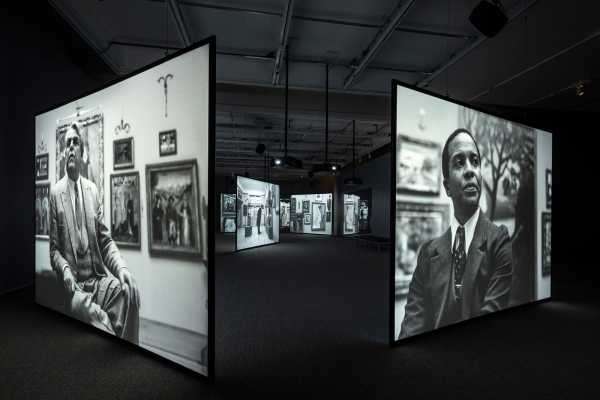
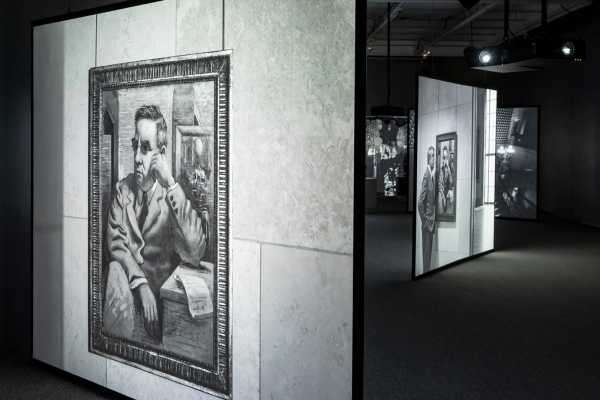
The Barnes, which commissioned the exhibition to celebrate its centennial, is pleased to frame it as a celebration of a pioneering interracial partnership. Yet Julien’s film slyly emphasizes the tensions between the two ambitious Philadelphians, particularly the difficulty, for Locke, of being instructed on his heritage by a notoriously self-regarding millionaire. (In a rare moment of comedy, Barnes, wearing sunglasses indoors, admires a portrait of himself by Giorgio de Chirico.) Deflecting Barnes’s assertions with consummate politeness, he lays out his own theory in more solitary scenes. African sculpture, Locke warns, has survived “a period of neglect and disesteem” only to end up “in danger of another sort of misconstruction, that of being taken up as an exotic fad and a fashionable amateurish interest.”
The dissonance offers a glimpse of a rivalrous relationship. According to Jeffrey C. Stewart’s Pulitzer-winning biography, Locke’s critical engagement with African sculpture essentially began with a visit to Barnes’s collection in 1924. Yet he quickly ran afoul of the white philanthropist’s territorial determination to become the Negrophile of Negrophiles. Barnes aspired to make the foundation a pilgrimage center for young Black artists, who would need to earn his favor if they wanted to master a tradition that “had long been dead in Africa” (as a monograph that his foundation commissioned erroneously claimed). When Locke repurposed insights gleaned from their conversations in his articles—a Promethean act of theft, in Stewart’s telling—Barnes was furious. Beyond the pettiness was a divide over whether “primitive” art was a blood transfusion for Western culture or the New Negro’s transformative inheritance.
Neither man wrote much about those from whom the art works were taken—an omission that Julien addresses in one of the film’s most extraordinary sequences. It begins with an overhead shot of the main exhibition hall at the Pitt Rivers Museum in Oxford, where anthropological artifacts from across the British Empire were warehoused. Locke, immaculately dressed, wanders among the crowded vitrines, crushing fallen leaves beneath his patent-leather shoes. The image recalls an elegy by the French Guyanese poet Léon-Gontran Damas, which a woman reads aloud at the start of the film: “How many of me me me have died since they came that night when the tam-tams rolled . . .the frenzy of eyes, the frenzy of hands, the frenzy of statues feet.” Locke says nothing, but leaves suppressing tears.
The woman’s voice, though, does return, as a mysterious curator joins Locke in the museum’s labyrinth. She weaves excerpts from Aimé Césaire, Wole Soyinka, and others in a plaintive monologue expressing the incalculable losses colonialism inflicted on African peoples. (Sharlene Whyte, whom Julien cast as Frederick Douglass’s wife Anna Murray Douglass in “Lessons of the Hour,” brings a restrained gravity to the role.) Later, she reads from the diary of a British officer present at the 1897 sack of Benin City: “Juju houses to be blown up. Walls and houses to be knocked down. Queen mother’s house to be burnt.” Behind the screens, a sixteenth-century statue looted from the city watches over the exhibition; it belongs to the Barnes Foundation. Here, as with his depiction of Barnes, Julien succeeds in creating a site-specific work of institutional critique unadulterated by the coöperating institution—a rare feat at a time when so many museums are shrewdly marketing the spectacle of reform. He describes the work as an act of “poetic restitution.”
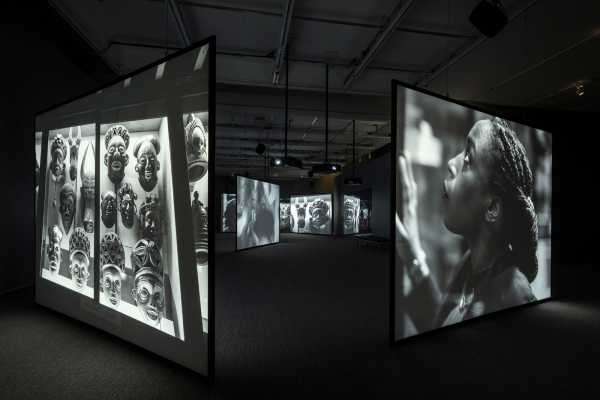
“In the museum, the rapture of self-gratification rots our eyes, a secret contempt of others dries up our hearts,” Whyte continues, quoting Aimé Césaire, as a Benin frieze scrolls by; on another screen, a gloved hand turns the pages of a photo album. She delivers a verdict: “No, in the scales of knowledge, the mass of all the museums in the world could never outweigh a lone spark of human empathy.” The collaged texts are paired with scenes from two classic films about plunder and repatriation: Nii Kwate Owoo’s “You Hide Me” (1970), which follows two young Africans into the storerooms of the British Museum, and Chris Marker’s “Statues Also Die” (1953), its title inverted in Julien’s. One strange fruit of colonial theft, Julien reminds us, was diasporic collaboration. But the weight of history, and the growing prominence of debates over restitution, throws a different light on Locke’s resurrection of African sculpture. What does it mean, we might ask, to fashion a New Negro from a kinsman’s scattered limbs?
Julien’s installation leaves open the possibility that Locke’s Africanism was a failure. He knew, and could know, very little about the sculptures he so admired—which, at the time, were frequently attributed to the wrong ethnic groups and eras. Nearly a century after he challenged Barnes, the millionaire’s institution endures, while Locke’s efforts to build his own led to embarrassment. Once, at the behest of Charlotte Osgood Mason—an even more zealously primitivist patron of the Renaissance—Locke reluctantly asked Paul Robeson to give a benefit concert for the museum while wearing an African mask. The great singer politely refused.
In the nineteen-thirties, many took a dim view of Locke’s Africanism, which was decried as a concession to segregation. Black artists of the next generation, such as Romare Bearden, revolted against the “coddling and patronizing” white benefactors the older man had worked with; by contrast, the New Deal created more neutral sources of funding for Black artists through programs such as the W.P.A. The critiques reached their zenith in the seventies, when historians like David Levering Lewis recast Locke’s endeavors, and the Harlem Renaissance, as an élite diversion of radical energy into the impotent world of high culture. Such arguments still have purchase, especially in an era when the prestige of Black art has again so far outpaced material progress for Black Americans as to cast doubt on any significant relationship between them.
But the art historian Kobena Mercer argues that Locke’s culturalism has been misconstrued. In a new book, “Alain Locke and the Visual Arts”—felicitously coincident with Julien’s installation—he convincingly challenges the “received image” of his subject as an “effete Afro-Edwardian aesthete” with no firm concept of the relationship between art, politics, and empire. Locke may have been a snob, but he was also, in Mercer’s account, a pragmatist, who believed that Black political solidarity needed a renewed cultural foundation; an anti-imperialist, sensitive to the ways that colonialism had transformed native art into creative capital; and a pluralist, whose interest in African sculpture was less a backward-looking reclamation of roots than a reckoning with loss prerequisite to cross-cultural renewal.
Although Locke’s museum was never built, he did make a significant body of African sculpture accessible to Black American artists. In 1926, he persuaded a friend to purchase a few dozen Congolese art works from a Belgian diplomat, and these pieces later toured historically Black colleges throughout the United States. Now held by the Schomburg Center in Harlem, the collection likely influenced Romare Bearden, who incorporated the blue patterning of one distinctive Kuba mask from the collection into his painting “The Family.” (The post-Harlem generation may have rejected aspects of Locke’s Africanism, Mercer explains, but they had already digested its insights.) Another influential legacy was “The Negro in Art” (1940), a picture book whose juxtaposition of African, European, and American traditions was ahead of its time in its proto-multiculturalism and rejection of “evolutionist” chronology. The freedom of print reproduction, Mercer explains, allowed Locke to build what André Malraux called a musée imaginaire, showcasing the many ways in which “elements that survived a catastrophic past may undergo metamorphosis and be granted an afterlife.”
Artists of the era shared Locke’s emphasis on death and resurrection. Reflecting on works by Palmer Hayden, Malvin Gray Johnson, Lois Mailou Jones, and others, Mercer demonstrates that mourning was central to Harlem Renaissance Africanism. Masks that often appeared in still-lifes from the era, he writes, can be seen as analogous to the skulls in the Western tradition of vanitas or memento mori. In a striking interpretation of Jones’s celebrated painting “Les Fétiches” (1938), which depicts an ensemble of African statuary swirling in a charged darkness, he writes that the work embodies not a straightforward reclamation of roots but the tragedy and the promise of diaspora. “Jones’s masks are double-facing,” he writes, “for they are abyss-crossing icons of black survival, open to new constellations in a galaxy of multiple possibilities for the future of black life.”
Perhaps the most fascinating argument that Mercer advances concerns sexuality. Locke came of age amid a Victorian wave of gay aestheticism that looked to classical art as inspiration for a new homosexual identity. Photographers such as Fred Holland Day and Wilhelm von Gloeden staged homoerotic scenes from antiquity with contemporary models, while writers such as John Addington Symonds—who, in an 1878 translation, brought out of the closet Michelangelo’s sonnets to his young lover—began to reconstruct the literary history of gay love. Nearly as popular as Greek motifs were Black male models, whose appeal, Mercer says, derived in part from the association of racial difference with sexual transgression. This Victorian alignment of the Black male body with classical homoeroticism set the stage for the Harlem Renaissance, when Black artists and a few white fellow-travellers mobilized it for their own ends. In art works such as Richmond Barthé’s sculpture of Féral Benga, a Senegalese dancer, swaying gently with a sword; Carl van Vechten’s private photo-portraits of naked models posing with African statuary; or Richard Bruce Nugent’s sensuous silhouette illustrations for Fire!!, the Black male body became a vector of the future—or, as Mercer puts it in the title of his final chapter, “Homo Negro, Endlessly New.”
The phrase captures a symmetry between queer self-fashioning and the African American search for heritage. Neither Victorian gays nor New Negroes could simply inherit their identities; instead, each group had to invent its ancestors, piecing them together from discontinuous pasts. Although Locke is often called the godfather of the Harlem Renaissance, Mercer notes that he liked to describe himself as its midwife, a label that he borrowed from Socrates. If fatherhood implies one all-determining lineage, queer midwifery suggests a more collaborative approach to cultural identity—a chosen family of ancestors and ancestral arts. It’s an ethos that lives on in the work of artists like Isaac Julien, a longtime friend and collaborator of Mercer’s and someone whose cinematic constellations he cites as an influence on his approach. How appropriate, then, that “Statues Never Die” moves from the graveyard of the anthropology museum to the erotics of the workshop, where the act of looking together at the past allows something new to begin. ♦
Sourse: newyorker.com